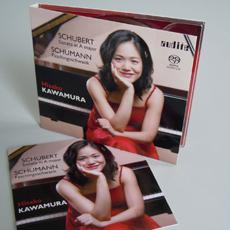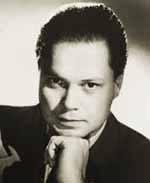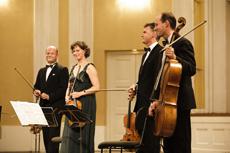“When, after four concerts in two days, the Mandelring Quartet "lived out" the last, sparse notes of Shostakovich's 15th String Quartet, softly blowing away on Friday after 10:00 PM at the Mozarteum, it was finally time to give them a standing ovation. Pure silence following the evermore magnificent, intensive and unique artistic effort would have been more appropriate, but it would not have sufficiently expressed the gratitude owed to Sebastian, Nanette and Bernhard Schmidt and Roland Glassl for their enormous achievement – the complete performance of all the Shostakovich quartets. … A memorable festival experience that cannot soon be repeated.” (Salzburger Nachrichten, 22.8.11)
“With each work that brought the Schmidt siblings and violist Roland Glassl as the "Mandelring Quartet" closer to the final 15th, the intensity in the musicians' playing increased – as far as one can seriously affirm this, after twelve concert hours within two days, of a complete string-quartet cycle that will continue to occupy us for a long time ... simply breathtaking.” (Salzburger Volkszeitung, 22.8.11)
“But already in the Second Quartet of 1944, written immediately after the Piano Trio, Op. 67, the tone becomes strikingly darker. The Mandelrings reveal a good flair for the characteristically rhapsodic style and the broad, almost symphonic breath also permeating the chamber music of Shostakovich from this point onwards … The Mandelrings remained true to their rather reserved interpretative approach on the second day of the Salzburg cycle as well. In so doing, they placed themselves in the same tradition with the first interpreters of these works, the Beethoven Quartet of Russia who – unlike their contemporary competitors, the Borodin Quartet – largely abstained from all high-pressure expression whilst bringing out the increasingly resigned radical quality of this music all the more strongly. … Shostakovich himself sarcastically provided these performing tips for his harrowing E-flat minor Quartet of 1974: "Play the first movement so that the flies fall dead from the sky and the public leaves the hall out of sheer boredom." The Salzburg audience, however, deeply moved, remained seated until the bitter end.” (Frankfurter Allgemeine Zeitung, 24.8.11)
“Stunning Mandelring Quartet in Salzburg – A Great Moment for Music Nearly 30 years of quartet-playing experience, and that amongst siblings and friends no less, is an absolute guarantee for perfect ensemble playing. When one adds artistic ambition and performs Shostakovich's 15 Quartets – probably the most important quartet cycle of the twentieth century - within two days during the course of the Salzburg Festival, then such a project can become a great moment. And this was indeed the case with the Mandelring Quartet at the Great Hall of the Mozarteum on Thursday. … The Mandelring Quartet was once again able to display its inimitable characteristics. Especially impressive were the slow movements, which were lent an incredible depth under the bows of the Mandelrings.” (Oberösterreichische Nachrichten, 20.8.11)
“The Mandelring Quartet is to be admired. Sebastian, Nanette and Bernhard Schmidt as well as Roland Glassl (viola) work out concentrated nuances and refinements, intensifying their playing during brutally rapturous cascades without ever surrendering their control over tone quality and sound. They are ideally-matched executors of these works.” (DrehPunktKultur.at, 19.8.11)
Shostakovich’s string quartets form probably the most important quartet cycle of the entire 20th century. They bear witness to the composer’s creativity across almost half a century, from his first quartet, written in 1938 at the age of 32, to his last work, dating from 1974, the year before his death. The Mandelring Quartet completed an acclaimed recording of these works in 2009 at audite. It has received several awards and been judged one of the outstanding complete recordings of our time. Fono-Forum wrote: “[….] at the highest level! This quite astonishing achievement is all the more valuable because it is impossible to get to the heart of these complex works through virtuosity or immaculate playing technique alone.” BR-Klassik added: “The Mandelring Quartet deserves our thanks for bringing us a new benchmark recording of one of the greatest quartet cycles of the 20th century.” Pizzicato summed it up: “In this new recording these musicians surpass what has already been achieved [….]. But the most surprising element in the Mandelring Quartet’s interpretation is the beauty of the music, despite all the inner turmoil, tragedy, lamentation and despair that it expresses. It is so beautiful that it almost brings tears to the eyes. Such is the effect of musical truth.” As the leading international musical magazine The Strad wrote: “… the Mandelring Quartet makes it abundantly clear that it is building one of the outstanding cycles in today’s catalogue.” The name of the most high-profile ensemble on the international chamber music scene conceals three Schmidt siblings: the brothers Sebastian (violin) and Bernhard (cello) and their sister Nanette (violin), together with Roland Glassl (viola). Distinguishing features of the Mandelring Quartet are its expressivity and phenomenal homogeneity of timbre, intonation and phrasing. Its exceptional quality and the breadth of its repertoire are confirmed by numerous CD recordings, the repeated award of the German Record Critics’ Prize, and nominations for the Cannes Classical Award and the International Classical Music Award. Recital tours have taken these players to the leading musical centres of Europe, North and South America, the Near East and the Far East. In 1997 the quartet founded its own music festival, the annual HAMBACHERMusikFEST, and since 2009 it has had its own concert series in its home town of Neustadt on the Weinstrasse, and in the Berlin Philharmonic Hall. More informatione at www.mandelring.com
Photo credit: © Wolfgang Lienbacher





